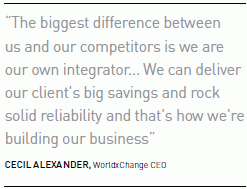Published on the 08/07/2011 | Written by iStart

AT A GLANCE
- IAG (NZ) Ltd
INDUSTRY
- Financial Services
BUSINESS OBJECTIVE
- To reduce base costs of telephony services, while ensuring a robust and resilient service.
SOLUTION
- WorldxChange SIP
THE BENEFITS
- Significant savings on toll and 0800 charges
- Increased redundancy
- Improved system stability
FOR MORE INFORMATION
WorldxChange Ltd
W: www.wxc.co.nz
E: info@wxc.co.nz
T: +64 9 950 1300
Tollfree: 0800 123 456
When NZ’s largest insurance company sent out an RFP, specialist IP telco WorldxChange spotted an opportunity to deliver a new world of gain…
IAG NZ Ltd is New Zealand’s largest general insurer and trades under the NZI and State Insurance brands. The company operates call centres in Auckland, Hamilton, Wellington and Christchurch, employing over 2,000 staff nationally.
When current CIO Allan Dornan joined IAG in 2005 he says an evaluation of the company’s telephony platform revealed operational expenses out of synch with comparable organisations he’d worked for in the UK. “The cost base seemed too high,” he says, “so we went through a RFP process that saw us weigh up the existing suppliers.”
A number of suppliers including SIP provider WorldxChange (WxC) pitched for the business, and when the bids came in Dornan says it was clear IAG could potentially save “a lot of money” by moving its telephony business to WxC.
Although the savings on toll charges and 0800 numbers were exciting in their own right, what really caught Dornan’s eye was that WxC’s solution centred around a SIP installation. First commercialised in 2001, SIP (Session Initiation Protocol) is a technology Dornan says he’d seen deployed in the UK to great effect.
“In the old traditional solutions you’d have a thousand or more ISDN lines coming into your PABX,” he says, “and it cost a lot of money to rent those. What SIP does is it gives you one IP Data pipe instead, and SIP does all the signalling for setting up your calls.”
With SIP taking ISDN lines out of the picture, Dornan says the cost savings are huge – and only WxC was offering it.
“It’s been clear to me for a while that the future of voice interconnect is SIP based telephony,” he says, “but when we looked at others – they basically didn’t have a story at that time.”
This doesn’t mean that Dornan immediately signed on the dotted line, however. In an industry as keenly sensitive to risk as insurance, Dornan is actually an especially cautious operator – having seen first hand the effect of telephony meltdowns earlier in his career. Assisting with a 10,000 line crash in one UK organisation, he says things were so bad the company had to invoke its disaster recovery plan and bring in a PABX on a trailer.
“That was a lesson to me,” he says, “in what it looks like when you don’t have a phone system in a big company.”
Given IAG’s customer services are almost entirely telephony based, Dornan says without phones “money would stop coming in the door” – a risk he wasn’t prepared to take. But while the large telcos did provide an element of big brand comfort, the technological and financial case for moving to WxC was compelling – he just needed to be convinced they could be relied on to handle the job.
Even after his systems architecture team returned from meetings with WxC with high praise for the capabilities of the company’s operations team, he says it still wasn’t enough to convince him. “My other concern was from a redundancy and fail over perspective,” he says. “I insisted they show us how redundancy would work, and what they had that was impressive was two points of presence so that you could link into their network in two places. We would actually end up with more redundancy than we already had.
Frankly, that sealed the deal as far as I was concerned.”
With an agreement in place WxC moved quickly and its IAG SIP solution went live in April 2009 – and it wasn’t long before Dornan found his confidence in the smaller, more focused telco had been well placed.
“The cost savings we expected have been delivered,” he says.
Commenting on KPIs beyond cost savings, Dornan says in system stability terms WxC has set new benchmarks. “Their reliability has been tremendous,” he says. “I think we’ve had two small glitches – and that compares very favourably with our previous experience.”
WxC CEO Cecil Alexander says the key to his company’s success is best of breed technology and a laser-like focus on excellence in deployment.
“It all comes down to how you build your network,” he says. “The biggest difference between us and our competitors is we are our own integrator. We don’t hire in outside resources to do the smarts that run the network or supply services to a customer. We create those, we build them, we evaluate them and we execute them. We can deliver our client’s big savings & rock solid reliability and that’s how we’re building our business.”
And those client’s don’t have to be big to make the kind of percentage savings seen at IAG he says.
“Basically any size organisation that’s using standard tolls or renting ISDN lines can benefit from switching to WxC.
Almost all PABX systems built in the last five years are SIP capable, and if they’re older than that they can still be SIP enabled via a gateway. There’s essentially no technological barrier preventing a business from moving to SIP telephony right now – and every reason why they should.”



























